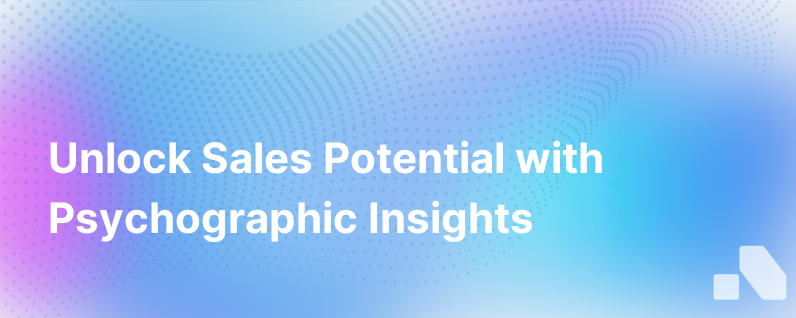Demystifying Psychographics
Published on September 14, 2023 by Sawyer Middeleer
Demystifying Psychographics: Understanding the Human Behind the Customer Profile
Psychographics has gradually become a buzzword within the realms of marketing and sales, representing a paradigm shift from traditional demographic targeting to a nuanced understanding of customers' psychological attributes. Unlike demographics, which categorize populations based on tangible factors such as age, gender, and income, psychographics peers into the layers of consumer behavior, uncovering motivations, values, attitudes, and lifestyle choices. In this article, we will journey through the universe of psychographics to unearth the core components, strategies for data collection, and methods of utilizing psychographic insights to bolster engagement and conversion.
The Essence of Psychographics
At its core, psychographic segmentation is about discerning the 'why' behind customer decisions: Why do individuals make certain purchasing choices? Why do specific messages resonate more with one subgroup over another? Why do customers exhibit fierce loyalty to certain brands? Psychographics addresses these questions by segmenting markets based on psychological characteristics. This can be broken down into several primary elements:
- Personality Traits: The OCEAN (Openness, Conscientiousness, Extroversion, Agreeableness, Neuroticism) model is a classic framework that categorizes individuals based on their dominant personality traits.
- Values: Values are the guiding principles that dictate life choices, such as the importance of family, environmental conservation, or wealth accumulation.
- Attitudes: These are predispositions towards specific concepts, items, or services that can significantly influence purchasing behaviors.
- Interests: Involving hobbies, leisure activities, and entertainment preferences, interests can be highly predictive of consumer alliances.
- Lifestyles: A holistic picture of a person's daily life, including work, social activities, and product preferences, which aligns closely with purchasing patterns.
Strategies for Gathering Psychographic Data
An insightful psychographic profile is derived from a rich tapestry of data sources. While the task might seem daunting, there are efficient and effective means to gain this valuable information:
- Surveys and Questionnaires: Directly asking customers to share their preferences, lifestyles, and opinions is a tried-and-true method. Thoughtfully designed questionnaires can reveal in-depth insights.
- Social Media Analytics: Social platforms offer a treasure trove of data. Analyzing likes, follows, shares, and comments can paint a vivid picture of psychographic segments.
- Focus Groups: Group discussions can uncover deeper motivations and attitudes compared to surveys, thanks to the dynamic nature of conversation and debate.
- Purchase Behavior Analysis: Historically, purchase data can implicitly suggest psychographic details based on the types and patterns of products bought.
- AI-Driven Analytical Tools: Advanced software such as Aomni can aggregate and analyze disparate data sources, generating psychographic insights with unprecedented depth and accuracy.
Leveraging Psychographics for Marketing and Sales
Understanding your customers on a psychographic level allows marketing and sales teams to connect on a more personal and emotional level. Here's how teams can operationalize psychographic insights:
- Personalized Messaging: Using psychographic data, tailor marketing messages to align with the target audience's values, attitudes, and lifestyles. This increases relevance and potency.
- Content Strategy: Creating content that strikes a chord with the internal drivers of customers can substantially heighten engagement and brand sentiment.
- Product Alignment: Modify or develop products and services to better reflect the interests and values of your target audience to increase both adoption and satisfaction.
- Market Segmentation: Going beyond demographic segmentation, companies can create psychographic profiles leading to more precise targeting.
- Narrative Marketing: Crafting stories that resonate from a values and lifestyle perspective can forge stronger emotional connections.
- Behavior Prediction: Predict future buying patterns based on understanding psychographic-driven motivations, anticipating customer needs before they fully materialize.
Psychographics in Action: A Hypothetical Scenario
Imagine a wellness brand that markets organic dietary supplements. Standard demographics might suggest targeting health-conscious adults; however, this is a broad category. By delving into psychographics, the brand distinguishes multiple customer types: one motivated by environmental activism, another by a desire for peak fitness performance, and a third driven by holistic health.
For the eco-conscious group, marketing collateral emphasizes the brand's commitment to sustainable sourcing and eco-friendly packaging, while offers to donate a portion of sales to environmental causes resonate strongly. To the fitness performers, messages revolve around how the product enhances athletic endurance and recovery, endorsed by credible athletes. For the holistic health audience, content focuses on the harmony of body and mind, supported by testimonials from yoga practitioners and nutrition experts.
Concluding Thoughts
Unveiling the psychological complexity of your customers should not be an enigma wrapped in a riddle. With the correct strategy and tools, psychographic segmentation evolves from an abstract concept to an actionable insight source. By incorporating a human-centric perspective into marketing and sales strategies, businesses can craft experiences that resonate profoundly with their audience on an individual level.
In an era where personalization is not just appreciated but expected, psychographics offer an invaluable compass to navigate the intricate landscape of human decision-making. Marketers and sales professionals armed with robust psychographic profiles will find themselves better equipped to deliver personalized, high-impact experiences that inspire loyalty and drive conversion.